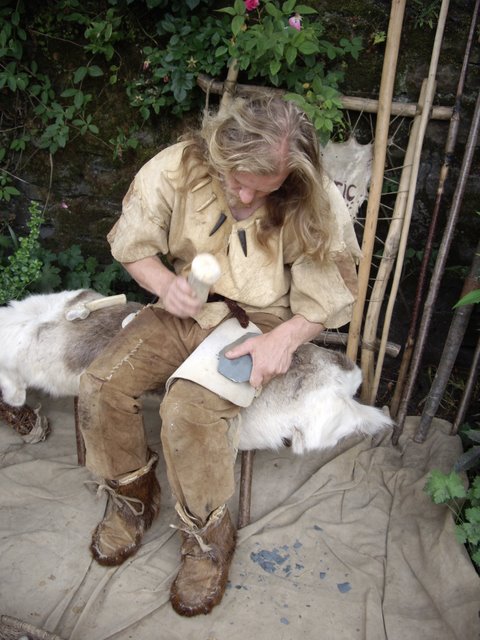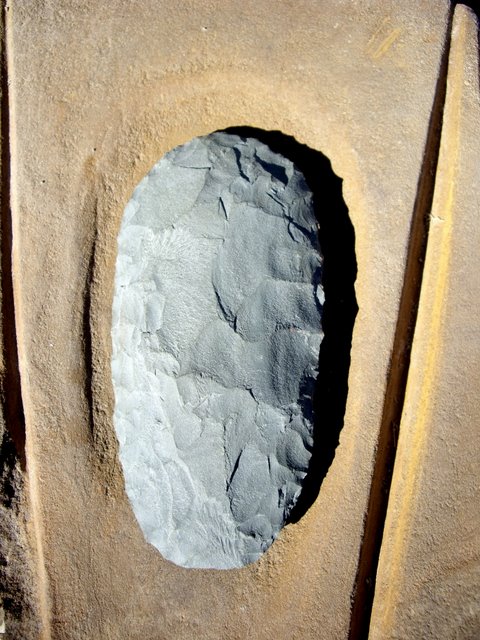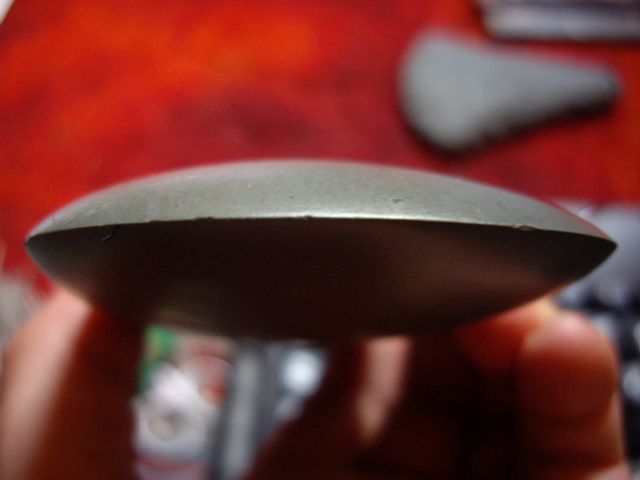Hi all, I'm new to the forum!
My interests are primarily with the Stone Ages and recently the Bronze Age - I'm finishing a Ewart-Park phase shortsword that was cast by Dave Chapman.
I've produced a number of Langdale greenstone tuff axes for archaeologists, some of which were featured recently on the National Geographic TV channel. I'm hoping to be of some help to members here if they have enquiries about lithics/type of stone etc, though I realise most of the members here are 'metalheads'! :)
Over the years, while browsing, I've come across several posts from here and have been very impressed. Particularly with Jeroen Zuiderwijk's work - his involvement with the Dutch Bronze Age and his excellent reproductions.
Hi Jon,
Welcome to myArmoury!
It's great to have more knowledge related to the stone age period. I find the art of stone weapon/edge (knapping) very facinating.
Welcome to myArmoury!
It's great to have more knowledge related to the stone age period. I find the art of stone weapon/edge (knapping) very facinating.
Hi Jon, and welcome aboard. I'm looking forward to some stone age discussions. You mention that you have made some greenstone axes in the past, would you happen to have any picture?
Ave, Jon!
Have you been to the Bronze Age Center?
http://s8.invisionfree.com/Bronze_Age_Center/index.php?
(Should you happen to sign up there, just remember to use your real first and/or last name, please!) We'd LOVE to see some of your work, yes! Not enough stone stuff around.
Welcome!
Matthew
Have you been to the Bronze Age Center?
http://s8.invisionfree.com/Bronze_Age_Center/index.php?
(Should you happen to sign up there, just remember to use your real first and/or last name, please!) We'd LOVE to see some of your work, yes! Not enough stone stuff around.
Welcome!
Matthew
Hello again - and thanks for the welcome!
I've got a pretty substantial personal collection of stone artefacts from the stone age(s) and maintain an interest in experimental archaeology, which takes up a good deal of my time. I love it!
I've got a couple of pics for you, which illustrate the recent production of one of a series of repro axes. This example is now in a private collection, but is currently on show in Penrith Museum. My pal Will Lord is knapping greenstone tuff, gathered (with permission) from the Neolithic Axe Factories in Langdale, Cumbria. I had to transform the 'roughed-out' axes into ground (and eventually polished) tools. This was achieved using a variety of methods - both ancient and modern. Physically hard and mentally demanding work - but I can say I enjoyed every minute! :)
Enjoy!
 Attachment: 82.71 KB
Attachment: 82.71 KB

 Attachment: 95.54 KB
Attachment: 95.54 KB

 Attachment: 72.72 KB
Attachment: 72.72 KB

I've got a pretty substantial personal collection of stone artefacts from the stone age(s) and maintain an interest in experimental archaeology, which takes up a good deal of my time. I love it!
I've got a couple of pics for you, which illustrate the recent production of one of a series of repro axes. This example is now in a private collection, but is currently on show in Penrith Museum. My pal Will Lord is knapping greenstone tuff, gathered (with permission) from the Neolithic Axe Factories in Langdale, Cumbria. I had to transform the 'roughed-out' axes into ground (and eventually polished) tools. This was achieved using a variety of methods - both ancient and modern. Physically hard and mentally demanding work - but I can say I enjoyed every minute! :)
Enjoy!



Certainly looking forward to having a look in the Bronze Age Centre when time allows! :)
Just welcome to the site and I look forward to posts and Topics from you that will give us more knowledge of a period and period tools and weapons most of use know much too little about.
Just as a breaking the ice question: When you work on various stone tools do you generally wear eye or hand protection for safety reasons ? I think I also read somewhere that some things like flint dust is not to good to get into you lungs as they act like microscopic razor blades and are not too good for the lungs.
I would guess that someone in period working stone tools many hours a day for years at a time this would become a health hazard but infrequent hobby work it might be less of a problem for the lungs ..... but a razor sharp flint or obsidian chips in the eyes can't be a good thing. ;)
I assume that for a public presentation in a living history context one could take a chance not wearing modern protective gear and competence and experience could diminish some risks a great deal.
Just as a breaking the ice question: When you work on various stone tools do you generally wear eye or hand protection for safety reasons ? I think I also read somewhere that some things like flint dust is not to good to get into you lungs as they act like microscopic razor blades and are not too good for the lungs.
I would guess that someone in period working stone tools many hours a day for years at a time this would become a health hazard but infrequent hobby work it might be less of a problem for the lungs ..... but a razor sharp flint or obsidian chips in the eyes can't be a good thing. ;)
I assume that for a public presentation in a living history context one could take a chance not wearing modern protective gear and competence and experience could diminish some risks a great deal.
If I'm grinding using power tools - regardless of the material, I always wear a mask. 99% of the time eye protection too - I've had a few bits of high speed flint to the cornea and it isn't much fun! It can of course lead to blindness in extreme cases. Inhaling lithic dust is always risky - it can lead to silicosis, which in extreme forms is fatal. The Brandon flint knappers, who produced gunflints in Norfolk suffered high mortality rates from inhaling large volumes of dust over extended periods.
Knapping for an experienced user isn't too hazardous, but sitting in on a workshop with novices can be dangerous - folks don't know what level of force to use - or the optimum angles for the strike - often resulting in sprays of razor-sharp flint being directed towards them....or their neighbours.
Knapping for an experienced user isn't too hazardous, but sitting in on a workshop with novices can be dangerous - folks don't know what level of force to use - or the optimum angles for the strike - often resulting in sprays of razor-sharp flint being directed towards them....or their neighbours.
Welcome Jon!
Thank you for sharing some very interesting photographs. The edge-on profile of the highly polished blade is just beautiful. I was not aware that one could achieve this type of result. Very nice. :)
Thank you for sharing some very interesting photographs. The edge-on profile of the highly polished blade is just beautiful. I was not aware that one could achieve this type of result. Very nice. :)
| Scott Hrouda wrote: |
| Welcome Jon!
Thank you for sharing some very interesting photographs. The edge-on profile of the highly polished blade is just beautiful. I was not aware that one could achieve this type of result. Very nice. :) |
I would imagine that the kind of stone would also be a factor in how polished one can get the surfaces.
One of the features of the fractured edge of a flint ot obsidian edge is that it's almost mono-molecular and very very sharp, is there a danger of loosing this extreme sharpness when polishing ? It might still be very sharp but one might " knock " and abrade away the extreme sharpness ?
But then again " Difference edges for different purposes " maybe: The ultra sharp great for skinning game but for chopping down a tree or using a harder stone to shape softer stone ( sculpture/masonery ? ) a less sharp but more durable edge might be preferable.
Excuse my ignorance of the subject but I think my questions give you the opportunity to discuss edge types and edge durability and what uses and challenges one would put one's stone tools or weapons too. ;) :D :cool:
Page 1 of 1
You cannot post new topics in this forumYou cannot reply to topics in this forum
You cannot edit your posts in this forum
You cannot delete your posts in this forum
You cannot vote in polls in this forum
You cannot attach files in this forum
You can download files in this forum
All contents © Copyright 2003-2006 myArmoury.com — All rights reserved
Discussion forums powered by phpBB © The phpBB Group
Switch to the Full-featured Version of the forum
Discussion forums powered by phpBB © The phpBB Group
Switch to the Full-featured Version of the forum